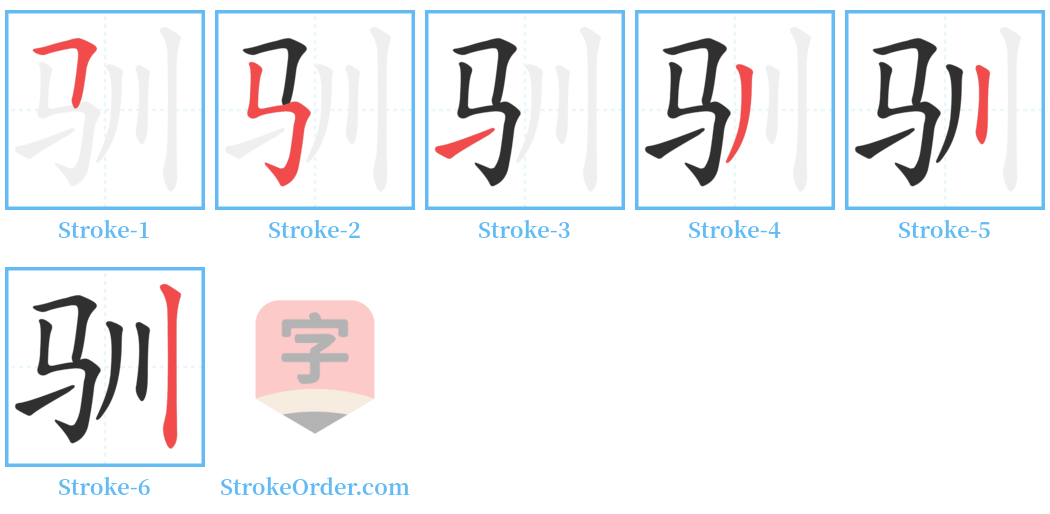驯 Stroke Order
Animated Stroke Order of 驯

Stroke Order Diagrams for 驯

Step-by-Step Handwriting Guide for 驯

Learn to Write Chinese Characters with Video Tutorials
Watch the video of writing the Chinese character "驯", learn the correct stroke order (笔顺) of the character "驯", and master the standard way of writing the character "驯".
Free Printable Handwriting Practice with Stroke Order: 驯
Printable Writing Practice Worksheet of "驯" in Portrait Orientation (Tian Zi Ge)

Printable Writing Practice Worksheet of "驯" in Landscape Orientation (Tian Zi Ge)

Information of 驯
Pinyin
xùn
Radical
马
Strokes
6 strokes
Usage
★★★★★
Definition
attain gradually / tame
驯 (xùn)
1. 顺从,使顺从。
To obey; to make obedient.
2. 善良,温顺。
Kind; gentle.
3. 古同“训”,教诲。
Same as "训"; to teach.
1. 顺从,使顺从:~化。~兽。~顺。桀骜不~。
To obey; to make obedient: domestication; taming beast; obedience; rebellious and untamed.
2. 善良,温顺:~良。~和。~谨。~熟。
Kind; gentle: kind-hearted; gentle and mild; cautious; familiar.
3. 古同“训”,教诲。
Same as "训"; to teach.
驯 (xùn)
形 (adjective)
【本义】:马驯服
Primary meaning: horse is tamed.
【造字法】:形声。从马,川声。
Character creation: phonetic compound, composite of horse and sound indicator.
1. 同本义。亦指鸟兽驯服 ([En.] horse is tame; animal is tame)
Same as the primary meaning. Also refers to the taming of birds and beasts.
引
1. 《说文》:驯,马训也。
From "Shuo Wen": 驯, the taming of horses.
2. 《一切经音义》引《说文》:养野鸟兽使服谓之训。
From "Yiqie Jing Yin Yi" quoting "Shuo Wen": raising wild birds and beasts to make them obedient is called "训".
3. 《字林》:驯,性行调顺也。
From "Zi Lin": 驯 means disposition and behavior are harmonized.
4. 《史记·司马相如传》:乃驾驯駮之驷。
From "Records of the Grand Historian": Thus drove the tamed and trained horses.
5. 《汉书·武帝纪》:南越献驯象。
From "Book of Han": Nanyue presented tame elephants.
6. 《淮南子》:马先驯而后求良。
From "Huainanzi": First tame the horse before seeking good ones.
7. 唐·韩愈《送惠师》:江鱼不池活,野鸟难笼驯。
From Tang Dynasty, Han Yu's "Sending Master Hui": River fish do not live in pools; wild birds are hard to catch and tame.
例
又如:驯兽(驯服之兽);驯雉(驯顺的雉);驯禽(驯养的禽鸟);驯鹿(驯养的鹿);驯乌(驯顺的乌鸦);驯象(驯养的象)
For example: tamed beasts; tamed pheasant; domesticated birds; domesticated deer; tame crow; domesticated elephant.
2. 泛指顺服 ([En.] be tame and docile)
Generally refers to being obedient and docile.
引
1. 《史记·五帝纪》:能明驯德。
From "Records of the Grand Historian": Able to understand the virtue of being obedient.
2. 《易·坤》:驯至其道。
From "I Ching": Tame and follow the way.
3. 《史记·万石君传》:驯行孝谨。
From "Records of the Grand Historian": Behaving obediently and reverently.
4. 宋·苏轼《放鹤亭记》:山人有二鹤,甚驯而善飞。
From Song Dynasty, Su Shi's "Record of the Crane Releasing Pavilion": The mountain man has two cranes, which are very tame and good at flying.
例
又如:驯良;驯顺(驯服和顺);驯狎(驯顺可亲近);驯懦(驯服懦弱);驯警(驯顺而有警觉);驯粗(驯服而有野性)
For example: obedient and kind; tamed and docile; approachable; submissive and timid; obedient yet alert; tamed but still wild.
3. 熟悉 ([En.] skill)
Familiar or skilled in something.
引
1. 清·施闰章《新都戍》:汉儿刍秣久,相驯通语言。
From Qing Dynasty, Shi Runzhang's "New Capital Garrison": The Han child has long been cultivating and is familiar with the language.
例
又如:驯悉(熟悉)
For example: familiar.
4. 善良 ([En.] good)
Good natured.
引
1. 清·王夫之《宋论》:知恶政之不可久,则虽苛烦之法,自可调之使驯。
From Qing Dynasty, Wang Fuzhi's "Discussion on Song": Knowing that harsh governance cannot last long, even troublesome laws can be adjusted to be good.
例
又如:驯谨(善良谨慎);驯行(善良的行为)
For example: gentle and cautious; good behavior.
驯 (xùn)
动 (verb)
1. 使驯服;使和顺 ([En.] domesticate; tame)
To make tame; to make docile.
引
1. 唐·玄奘《大唐西域记》:龙驹之子,方乃驯驾,所以此国多出善马。
From Tang Dynasty, Xuanzang’s "Great Tang Records of the Western Regions": The offspring of dragon horse, thus can be trained to ride, hence many good horses come from this country.
例
又如:驯驾(训练驾车);驯兽(使兽驯顺)
For example: training in driving; taming beasts.
2. 解释 ([En.] explain)
To explain.
引
1. 《墨子》:又以先王之书,驯天明不解之道也知之。
From "Mozi": Also using the books of the former kings to explain the path that heaven makes clear.
驯 (xùn)
副 (adverb)
1. 逐渐地,循序渐进 ([En.] gradually)
Gradually; step by step.
引
1. 《说苑》:学不陵节而施之曰驯。
From "Shuo Yuan": Learning is not hurried but applied gradually, which is called "驯".
例
又如:驯致(顺其自然而逐渐达到;顺应情致的自然发展);驯增(逐渐增加)
For example: gradually arriving at a natural conclusion; gradually increasing.
Input Method for 驯
Pinyin
xun4
Wubi
ckh|cgkh
Cangjie
nmlll
Zhengma
xnd
Four Corner
72100
Unicode
U+9a6f
Same Pronunciation Characters